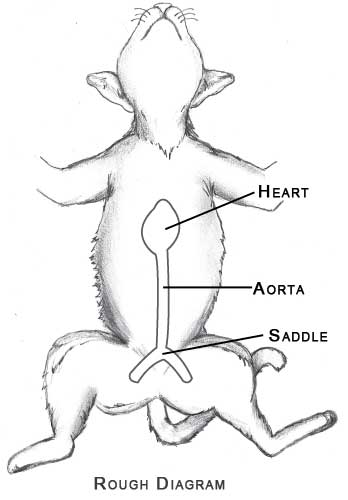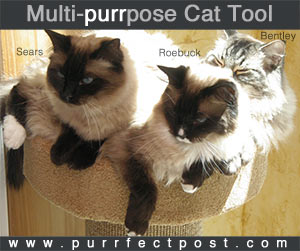Saddle Thrombus: Aortic Blood Clots in Cats
Feline aortic thromboembolism (FATE), also known as saddle thrombus is a serious and sometimes fatal complication of heart disease in cats. It affects as many as 25%of cats with hypertrophic cardiomyopathy, a common feline heart condition. FATE usually strikes without warning; in fact it may be the first and only sign of heart disease in some cases.

What Is Saddle Thrombus in Cats?
FATE occurs when a blood clot forms, usually in the heart, then breaks loose. It enters the circulation but eventually gets stuck, causing a blockage. This may be a small clot, or embolism or a large one, known as a thrombus. The most common blockage point is in the lower abdomen where the aorta, the main blood vessel leaving the heart, forms two branches going to the back legs (**see Rough Diagram**). This spot is known as the saddle, and it is common for the blood clot to come to rest at the top of that point, leading to the term saddle thrombus.
When blood circulation is blocked at the saddle, the rear limbs grow cold, and muscles and nerves swell due to lack of oxygen and nutrients. The patient is suddenly paralyzed and in severe pain.
Why Do Blood Clots Form in Cats?
Ninety percent of cats with FATE have a pre-existing heart problem such as hypertrophic cardiomyopathy (HCM). HCM causes structural changes in the heart that promote blood clot formation. The lower heart chambers, or ventricles, particularly the left ventricle, don't pump well when they are affected by HCM. Because of this, blood tends to pool and stagnate in the left atrium, the top heart chamber. Where blood flow is stagnant, clots tend to form. Inevitably, the clot or a fragment of it breaks loose and enters the circulation. A large enough clot forms a classic saddle thrombus, although smaller fragments have been known make it farther downstream to the intestines, kidney, or brain. Other causes of clot formation in the cat include hyperthyroidism and certain cancers, especially lung cancer.
Cat Breeds Susceptible to Blood Clots
Since FATE is often associated with heart disease, its prevalence follows the same patterns. Abyssinians, ragdolls, and Birmans are over-represented in FATE cases as are middle-aged males, because HCM is more common in these patients.
Signs of FATE in Cats
The signs of FATE come on suddenly and may include:
- Dragging of one or both hind legs.
- Difficulty breathing.
- Crying or screaming.
- Panting or open-mouthed breathing.
Your vet may also notice:
- Lack of pulses in one or both hind legs.
- Rear legs that are cool to the touch.
- Leg muscles that are hard and extremely painful.
- Paw pads and nail beds that appear cyanotic (blue-tinged).
- Heart murmur or arrhythmia.
- Abnormal lung sounds.
FATE is a serious medical emergency in the cat. If you suspect that your cat is showing signs of FATE, seek emergency veterinary care immediately.
Diagnosis of Saddle Thrombus in Cats
FATE is diagnosed based on its distinctive clinical presentation. Laboratory tests and diagnostic imaging may be needed to confirm the diagnosis, to detect underlying heart disease or heart failure, and to rule out other problems. Diagnostic workup includes:
- Complete blood count (CBC) to evaluate for anemia, infection, and blood clotting factors.
- Biochemistry profile to determine whether organ function is appropriate.
- Chest x-rays to evaluate the size and character of the heart and its associated blood vessels as well as the state of the lungs.
- Echocardiogram to evaluate for heart disease.
- Doppler test to confirm the absence of blood flow in the legs.
Treatment of FATE in Cats
FATE is an extremely serious and painful condition. Due to the uncertain outlook and the possibility of underlying heart disease, at least a quarter of pet parents elect humane euthanasia rather than treatment. Cats with acute FATE require intensive care in a hospital setting for the first 48 hours or more.
The goals of blood clot treatment include:
- Manage pain. Strong morphine-derived pain killers are used.
- Provide supportive care. Fluid therapy helps prevent dehydration and treat the circulatory shock caused by the clot, but it must be used carefully in heart disease patients. Strict cage rest is instituted and may last several days to weeks. A good deal of nursing care may be required to keep the paralyzed cat clean and comfortable while the hind legs slowly heal and regain function.
- Address underlying heart disease, if present. Heart medications and diuretics may be needed to boost heart function and treat heart failure.
- Prevent further clot formation. This piece is controversial. Aspirin has historically been the go-to drug, but newer studies are investigating the use of the human anti-clot drug, Plavix®.
Prognosis for Cats with FATE
The outlook for cats that have a saddle thrombus depends on the severity of the obstruction and the extent of the underlying heart disease. Cats with milder blockages that affect only one leg or don't cause complete paralysis of the legs can eventually recover full function and do relatively well. In one study, cats with a body temperature above 98.9˚ at presentation were 50% more likely to survive than those presenting with lower body temperatures. In another study, cats that presented in heart failure lived a median of 77 days whereas those without heart failure fared much better, with a median survival of 223 days. Complete recovery is rare, as recurrences of FATE are common and most cats have serious progressive heart disease as the underlying cause.
Prevention of Blood Clots in Cats
It's not known which factors predispose some cats with heart disease to forming clots while others don't, but HCM with enlargement of the left atrium are associated with FATE. Cats with these risk factors are sometimes treated with aspirin or Plavix® as a preventive measure. Please note that inappropriate dosages of these drugs can be extremely dangerous to cats. Never give medications to your cat that were not specifically prescribed by your veterinarian.
Recurrences of FATE are common, with one study reporting a rate of 40% over the ensuing 1-2 years. There is currently no preventive measure for HCM itself, although early detection and treatment slows the progression of the disease, hopefully sparing the patient its more serious complications, such as FATE.
You May Also Like These Articles:
Hypertrophic Cardiomyopathy HCM in cats
The Cardiovascular System of Cats
Feliway - A Useful Tool to Help Treat Stress in Cats
How To Take Your Cat To The Vet
How to Be Prepared for Your Cat's Veterinary Bills




